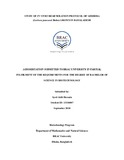| dc.contributor.advisor | Chowdhury, Jebunnesa | |
| dc.contributor.author | Hossain, Syed Akib | |
| dc.date.accessioned | 2018-12-02T05:14:44Z | |
| dc.date.available | 2018-12-02T05:14:44Z | |
| dc.date.copyright | 2018 | |
| dc.date.issued | 2018-09 | |
| dc.identifier.other | ID 13336007 | |
| dc.identifier.uri | http://hdl.handle.net/10361/10920 | |
| dc.description | This thesis is submitted in partial fulfilment of the requirements for the degree of Bachelor of Science in Biotechnology, 2018. | en_US |
| dc.description | Cataloged from PDF version of thesis. | |
| dc.description | Includes bibliographical references (page 46-48). | |
| dc.description.abstract | Gerbera jamesonii Bolus is one of the most widespread decorative plants in the world. The gerbera market would benefit from an efficient and simple protocol for high rate regeneration for propagation and genetic engineering. Various explants namely leaf and capitulum were found to favorably responsive towards different culture media with different types and concentrations of growth regulators. During this study, different experiments were designed to analyze different factors affecting in vitro regeneration of gerbera. These experiments were optimization of the sterilization procedure for leaf and capitulum explants, study of the regeneration response of these explants towards different media combinations, selection of suitable media composition for shoot regeneration and selection of gerbera explants that can give rise to regeneration. During the study, washing the leaf and capitulum explants under tap water for 20 minutes followed by surface sterilization with 0.1% HgCl2 for 6-7 minutes and 70% ethanol for 30-60 seconds respectively, found to be the best sterilization procedure. All types of explants were cultured on MS medium with different hormonal compositions and concentrations. Among the explants, capitulum was suitable and superior for callus induction and subsequent regeneration of in vitro shoots when cultured on MS media supplemented with 2 mg/l BAP and 0.5 mg/l NAA. Shoot proliferation was started within 6-7 weeks after inoculation of capitulum explants in the suitable medium (2 mg/l BAP and 0.5 mg/l NAA). However, callusing was observed in all leaf explants but they failed to differentiate into shoots in different media. The red variety showed best response in producing multiple shoots in comparison with the white variety. Attention should be paid to improve the regeneration percentage and reproducibility of the protocol in further studies. | en_US |
| dc.description.statementofresponsibility | Syed Akib Hossain | |
| dc.format.extent | 48 pages | |
| dc.language.iso | en | en_US |
| dc.publisher | BRAC University | en_US |
| dc.rights | BRAC University theses are protected by copyright. They may be viewed from this source for any purpose, but reproduction or distribution in any format is prohibited without written permission. | |
| dc.subject | Gerbera jamesonii | en_US |
| dc.subject | In vitro | en_US |
| dc.title | Study of in vitro regeneration protocol of gerbera (Gerbera jamesonii Bolus) grown in Bangladesh | en_US |
| dc.type | Thesis | en_US |
| dc.contributor.department | Department of Mathematics and Natural Sciences, BRAC University. | |
| dc.description.degree | B. Biotechnology
| |

